 Nissan Rogue: Three-point type seat belt
Nissan Rogue: Three-point type seat belt

- Every person who drives or rides in this vehicle should use a seat belt at all times.
- Do not ride in a moving vehicle when the seatback is reclined. This can be dangerous. The shoulder belt will not be against your body. In an accident, you could be thrown into it and receive neck or other serious injuries. You could also slide under the lap belt and receive serious internal injuries.
- For the most effective protection when the vehicle is in motion, the seat should be upright. Always sit well back in the seat with both feet on the floor and adjust the seat belt properly.
- Do not allow children to play with the seat belts. Most seating positions are equipped with Automatic Locking Retractor (ALR) mode seat belts. If the seat belt becomes wrapped around a child’s neck with the ALR mode activated, the child can be seriously injured or killed if the seat belt retracts and becomes tight. This can occur even if the vehicle is parked. Unbuckle the seat belt to release the child. For the center of the rear seat, the connector tongue may also be released.
Release the connector tongue by inserting a suitable tool (such as a key) into the connector buckle A. If the seat belt can not be unbuckled or is already unbuckled, release the child by cutting the seat belt with a suitable tool (such as a knife or scissors) to release the seat belt.
Fastening the seat belts
1. Adjust the seat. (See “Seats” earlier in this section.)
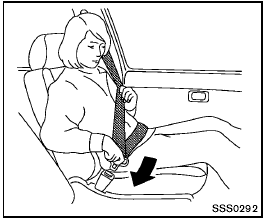
2. Slowly pull the seat belt out of the retractor and insert the tongue into the buckle until you hear and feel the latch engage.
- The retractor is designed to lock during a sudden stop or on impact.
A slow pulling motion permits the belt to move and allows you some freedom of movement in the seat.
- If the seat belt cannot be pulled from its fully retracted position, firmly pull the belt and release it. Then smoothly pull the belt out of the retractor.
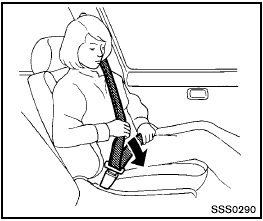
3. Position the lap belt portion low and snug on the hips as shown.
4. Pull the shoulder belt portion toward the retractor to take up extra slack. Be sure the shoulder belt is routed over your shoulder and across your chest.
The front passenger seat and the rear seating
positions three-point seat belts have two modes
of operation:
- Emergency Locking Retractor (ELR)
- Automatic Locking Retractor (ALR)
The Emergency Locking Retractor (ELR) mode allows the seat belt to extend and retract to allow the driver and passengers some freedom of movement in the seat. The ELR locks the seat belt when the vehicle slows down rapidly or during certain impacts.
The Automatic Locking Retractor (ALR) mode (child restraint mode) locks the seat belt for child restraint installation.
When ALR mode is activated the seat belt cannot be extended again until the seat belt tongue is detached from the buckle and fully retracted. The seat belt returns to the ELR mode after the seat belt fully retracts. For additional information, see “Child restraints” later in this section.
The ALR mode should be used only for child restraint installation. During normal seat belt use by an occupant, the ALR mode should not be activated. If it is activated, it may cause uncomfortable seat belt tension.

When fastening the seat belts, be certain that seatbacks are completely secured in the latched position. If they are not completely secured, passengers may be injured in an accident or sudden stop.
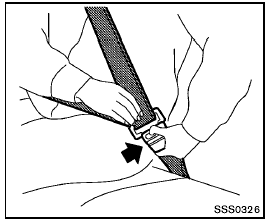
Unfastening the seat belts
To unfasten the seat belt, push the button on the buckle. The seat belt automatically retracts.
Checking seat belt operation
Seat belt retractors are designed to lock seat
belt movement by two separate methods:
- When the belt is pulled quickly from the
retractor.
- When the vehicle slows down rapidly.
Check the operation as follows:
- Grasp the shoulder belt and pull forward
quickly. The retractor should lock and
restrict further belt movement.
If the retractor does not lock during this check or if you have any question about seat belt operation, see a NISSAN dealer.
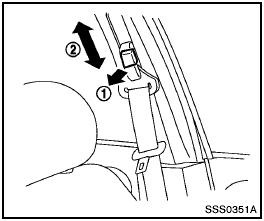
Shoulder belt height adjustment
The shoulder belt anchor height should be adjusted to the position best for you. (See “Precautions on seat belt usage” earlier in this section.) To adjust, pull the adjustment button 1 , and then move the shoulder belt anchor to the desired position 2 , so that the belt passes over the center of the shoulder. The belt should be away from your face and neck, but not falling off of your shoulder. Release the adjustment button to lock the shoulder belt anchor into position.

- After adjustment, release the adjustment button and try to move the shoulder belt anchor up and down to make sure it is securely fixed in position.
- The shoulder belt anchor height should be adjusted to the position best for you. Failure to do so may reduce the effectiveness of the entire restraint system and increase the chance or severity of injury in an accident.
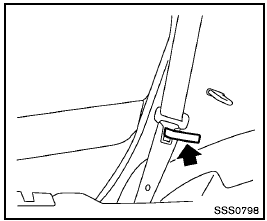
Seat belt hooks
When the rear seat belts are not in use and when folding down the rear seats, hook the rear outer seat belts on the seat belt hooks.
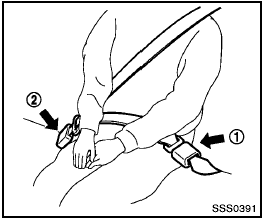
Rear center seat belt
The rear center seat belt has a connector tongue 1 and a seat belt tongue 2 . Both the connector tongue and the seat belt tongue must be securely latched for proper seat belt operation.
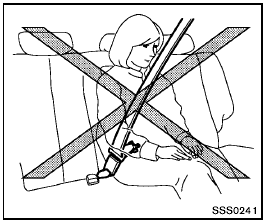

- Always fasten the connector tongue and the seat belt in the order shown.
- Always make sure both the connector tongue and the seat belt tongue are secured when using the seat belt or installing a child restraint. Do not use the seat belt or child restraint with only the seat belt tongue attached. This could result in serious personal injury in case of an accident or a sudden stop.
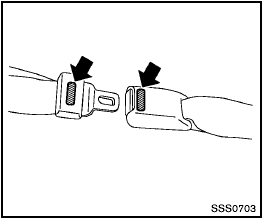
The center seat belt buckle and the tongue are identified by the CENTER mark. The center seat belt tongue can be fastened only into the center seat belt buckle.
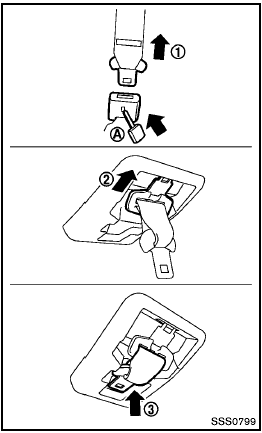
Stowing rear center seat belt:
When folding down the rear seat, the rear center
seat belt can be retracted into a stowed position
as follows:
1. Hold the connector tongue 1 so that the
seat belt does not retract suddenly when the
tongue is released from the connector
buckle. Release the connector tongue by
inserting a suitable tool such as key A into
the connector buckle.
2. Insert the seat belt tongue into the retractor base first 2 .
3. Then secure the connector tongue into the retractor base 3 .

- Do not unfasten the rear center seat belt connector except when folding down the rear seat.
- When attaching the rear center seat belt connector, be certain that the seatbacks are completely secured in the latched position and the rear center seat belt connector is completely secured.
- If the rear center seat belt connector and the seatbacks are not secured in the correct position, serious personal injury may result in an accident or sudden stop.
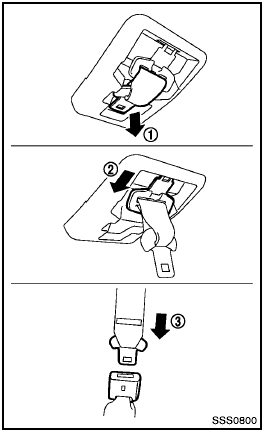
Attaching rear center seat belt:
Always be sure the rear center seat belt connector tongue and connector buckle are attached. Disconnect only when folding down the rear seat.
To connect the buckle:
1. Pull out the connector tongue from the
retractor base 1 .
2. Pull out the seat belt tongue from the retractor base 2 .
3. Pull the seat belt and secure the connector buckle until it clicks 3 .
The center seat belt connector tongue can be attached only into the rear center seat belt connector buckle.
To fasten the seat belt, see “Fastening the seat belts” earlier in this section.

- Do not unfasten the rear center seat belt connector except when folding down the rear seat.
- When attaching the rear center seat belt connector, be certain that the seatbacks are completely secured in the latched position and the rear center seat belt connector is completely secured.
- If the rear center seat belt connector and the seatbacks are not secured in the correct position, serious personal injury may result in an accident or sudden stop.
 Injured persons
Injured persons
NISSAN recommends that injured persons use
seat belts, depending on the injury. Check with
your doctor for specific recommendations. ...
 Seat belt extenders
Seat belt extenders
If, because of body size or driving position, it is
not possible to properly fit the lap-shoulder belt
and fasten it, an extender that is compatible with
the installed seat belts is available th ...
See also:
Emergency maneuvers
• In an unavoidable emergency situation where a sudden sharp turn
must be made, remember to avoid “over-driving” your vehicle, i.e.,
turn the steering wheel only as rapidly and as far as requi ...
Unlocking the driver's door (mechanical key)
If the vehicle can no longer be unlocked with the SmartKey, use the mechanical
key.
If you use the mechanical key to unlock and open the driver's door, the anti-theft
alarm system will be tri ...
Changing wheels with TPMS
Please note the following when changing or
replacing the factory installed TPMS wheels/
tires on the vehicle:
• Only the factory-mounted wheels are
equipped with TPMS sensors in the valves.
...
